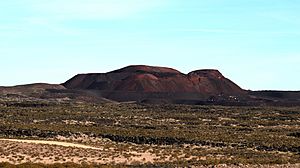Lavic Lake volcanic field facts for kids
Imagine a place in the desert where old volcanoes once erupted! The Lavic Lake volcanic field is a special area in the Mojave Desert in San Bernardino County, California, United States. It's home to several cinder cone volcanoes that are now extinct, meaning they won't erupt again. These cool volcanoes are right next to the famous historic Route 66 and the modern Interstate 40. You can find them between the towns of Barstow and Ludlow. The land here is about 762 meters (2,500 feet) above sea level.
Contents
What is the Lavic Lake Volcanic Field?
The Lavic Lake volcanic field covers about 100 square kilometers (39 square miles). It's mostly a flat area made of hardened lava, called a lava plain. This field has four main cinder cone volcanoes. Three of these cones are near the Lavic Dry Lake, and one is a bit further southwest in the Rodman Mountains.
When Did These Volcanoes Erupt?
Most of the volcanoes here are from the Holocene period, which started about 10,000 years ago. However, the oldest volcano, called Pisgah Crater, might be even older. Scientists think it erupted around 25,000 years ago!
Meet Pisgah Crater
Of all the volcanoes in the Lavic Lake field, Pisgah Crater is the easiest to see and visit. It stands about 100 meters (328 feet) tall above the surrounding land. Its highest point is about 776 meters (2,545 feet) above sea level.
Over time, people have used parts of Pisgah Crater for mining. They take rocks from it to use for building roads. This has changed the shape of the cone a bit.
Life in the Desert Volcano Area
The area around the Lavic Lake volcanic field is a desert. This means it's very dry. You'll find smaller plants growing in places where soil has collected. These pockets of soil are formed by wind and water moving dirt around.



